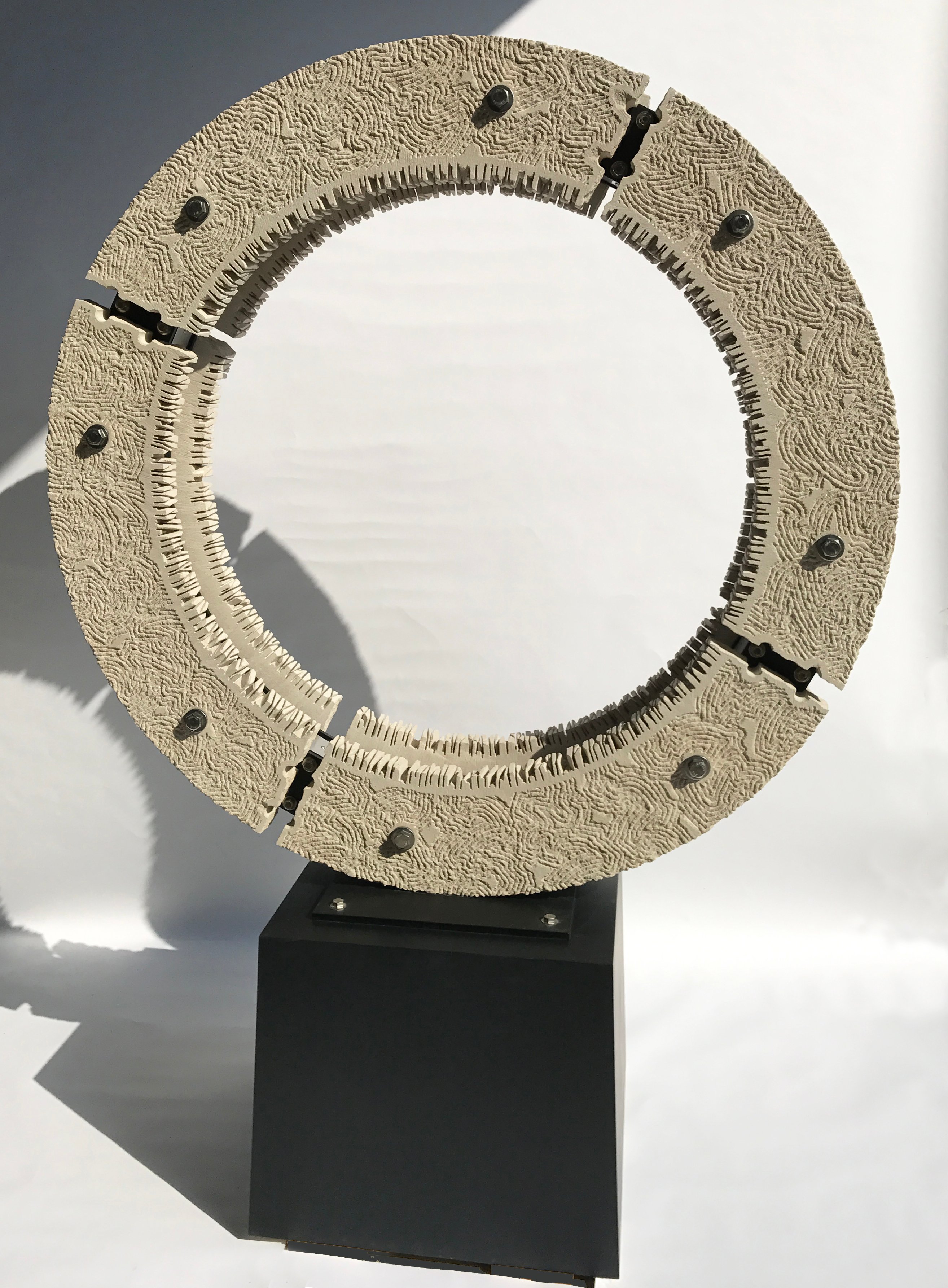
Sculptor Dale Enochs is back in the gallery for the first time in years. Perhaps best known for his public art, he is featured in a variety of collections including the Zhejiang Museum of Art, Indianapolis Museum of Art, and the Fort Wayne Museum of Art, but hasn’t been showing in a gallery context for a while—until now.
On view through September 30 at Long-Sharp Gallery, “Dale Enochs: On the Rocks” is a survey of the artist’s work spanning decades and sizes, ranging from a mere eight inches to a towering 9.5 feet. Here, Enochs discusses the show, the importance of light in sculpture, and setting ideas in stone (sorry).
Tell us about your current show at Long-Sharp Gallery.
This exhibit is a mixture of prints, stone wall pieces, pedestal sculptures, and free-standing pieces. Some of the work is older; several pieces were completed in the past couple of months. I tend to work in two modes, site-specific commissions and independent work. Aside from two maquettes of previous commissions, the work in the show is “independent.”
In recent years, I have been working on commissions and participating in group shows. I haven’t had the time or enough pieces to fill a one-person show in a number of years. In anticipation of the Long-Sharp Gallery exhibit, I created several pieces with the gallery in mind. I wanted some of the work to challenge the gallery space. These are taller pieces that could be assembled in the gallery almost at ceiling height. I believe that these pieces, due to their height and perceived weight, command a presence in the room.
Dale Enochs, Scholar’s Stone. Courtesy of Long-Sharp Gallery.
One of the pieces in this show, Postindustrial Mandala, incorporates LED lighting and is almost seven feet tall. Was this your first time working with LED?
As simplistic as this may sound, light is an integral part of sculpture. I have been working with “lighting” sculptures in order to accentuate the textures of my work for many years. At some point, I began thinking in terms of incorporating light as an integrated part of the work. I have a number of sketches that I’ve done that are exploring this direction.
Within the past several years, I have had the opportunity to incorporate LED lighting within two public pieces. The most successful of those pieces is Time Flow, a large composition installed at the Indiana Statehouse. There, I began to truly realize the effects, both physical and conceptual, that could be achieved from lighting within a piece. This aspect of my work is still in an embryonic stage. There is a lot to be explored.
What are the pros and cons of having work displayed publically?
I believe that all art is about communication and that the created work—be it sculpture, painting, poetry, music, etc.—has the potential to speak on a variety of levels. I am drawn to public art in part because public art is seen by people that have no familiarity with the art world. I’m referring to those that don’t tour art museums or galleries or have knowledge of art history. I am drawn to the challenge of making meaningful work that speaks to both the art enthusiasts and those that are unfamiliar with the art world.
A public setting gives me the opportunity to reference the environment, history, and subject among other aspects of a given project and attempt to meld them together into a cohesive, unified statement. If I am successful in my endeavor, people from all walks of life have visual and intellectual access to the work.
The downside of public work is vandalism.
Dale Enochs, Table Piece #2. Courtesy of Long-Sharp Gallery.
What is your favorite public work?
Two separate pieces come to mind, although one is technically “architecture.” The architectural “sculpture” Water Temple in Awaji, Japan by Tadao Ando is experiential. It is a temple, it feels like a temple and it causes you to know you are in a sacred space. All of this is done in utmost reserved simplicity.
I believe that Cloud Gate in Chicago by Anish Kapoor is experiential as well. This appropriately scaled organic form is experienced around, under, and through. To me, the reflective surface creates an ever-changing texture of color, the surrounding city and individuals nearby. The sculpture’s “presence” is its voice.
What’s next for you? Any upcoming projects or exhibitions?
I currently have four public works in various stages of development or discussion, three shows being discussed (as far as I can remember), and a private commission in discussion. As daunting as this may sound, not all of this is “set in stone” (sorry). I have been feeling extremely fortunate, exhilarated, and sometimes overwhelmed.
If you weren’t an artist, what other profession would you have gone into?
I believe that I have been very fortunate to have several significant mentors along the way. If I had not persisted to become an artist, I would have most likely worked in a factory. Had this transpired, I also believe I would have not lasted very long. I’m happy that I have been persistent.
Dale Enochs, 215 lbs. Courtesy of Long-Sharp Gallery.
The artnet Gallery Network is a community of the world’s leading galleries offering artworks by today’s most collected artists. Learn more about becoming a member here, or explore our member galleries here.